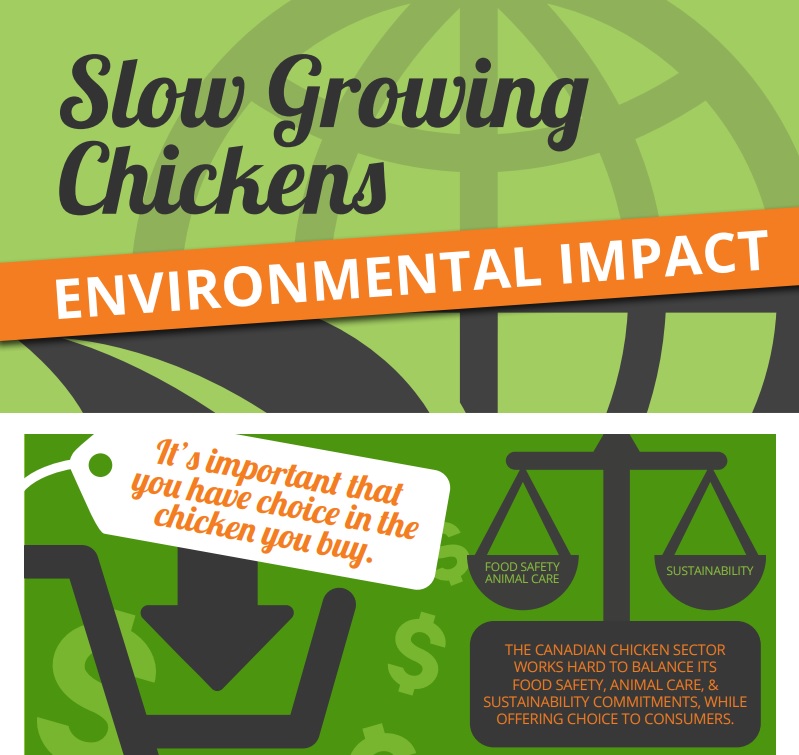Meet Your Farmers!
 Watch the video
Watch the video








The chickens raised in Canada today certainly grow faster – although not much bigger – than ever before. The majority of broiler chickens in Canada are marketed at around 2kg, which they generally reach by 35-36 days of age. This fast rate of growth has been a result of many factors, but genetic modification is not one of them.
Good breeding programs have been one factor, and poultry breeding companies have used the process of genetic selection to carefully select for desirable traits in broiler chickens. This is the same process that gives us Great Danes and Chihuahuas – it is not genetic modification.
Other factors that have improved chicken growth rates over the years include advances in nutrition and housing. Check out this factsheet to learn more.
Broiler chickens are never raised in cages in Canada. They live in large, well-ventilated barns where they are free to roam and access feed and water as they wish. This is known as “free-run” and provides protection from predators such as foxes, weasels, and skunks. With the hot summers and cold winters we have in Canada, this also allows farmers to produce fresh Canadian chicken all year-round.
Some Canadian farmers do raise “free-range” chickens which have outdoor access, depending on the age of the chickens and the weather conditions.
Check out the Farm to Table page to learn all about how chickens are raised in Canada.
Though it is rare, some marketers still classify their chicken as “hormone-free.” This is little more than a marketing tactic, since the use of hormones and steroids in raising poultry have been banned since the 1960s in Canada. For one thing, that would result in unhealthy, unmarketable birds, and farming is about growing healthy, safe and nutritious food. For another thing, it would cost an outrageous amount of money. And finally, it’s against the law.
Video courtesy of the BC Chicken Marketing Board
So why do chickens grow so fast now? It’s because of a combination of things, including good breeding programs, excellent nutrition, and advances in housing systems which keep the birds comfortable at all times. But it’s not because of added hormones or steroids. Check out this page to find out more about how chickens are raised in Canada.
Chickens are given a nutritionally balanced diet for their entire lives, which means it changes depending on their stage of growth. The same way puppies and senior dogs have different nutritional needs and therefore different food, the dietary needs of baby chicks and market weight chickens are different. Farmers work with nutritionists and independent experts to develop healthy diets for the birds, tailored to each stage of the chicken’s life.
Chickens in Canada eat a feed consisting of grain, grain by-products and protein-producing seeds (such as meal made from canola and soybeans). A small amount of other protein is added, such as bone meal and vegetable fats, as well as a small amount of vitamins and minerals. The chicken feed changes as the chickens grow, but it never contains added hormones or steroids. In fact, federal regulations prohibit the use of added hormones and steroids in all poultry.
Advances in nutrition, along with good breeding programs and improvements in housing conditions have created the broiler chickens of today, and by many accounts they have better health and welfare than ever before.
The term “broiler” is used to describe a chicken raised for meat, not eggs. Broiler chicks hatch from fertilized eggs produced on what are known as broiler breeder farms. The eggs we eat are completely different, are unfertilized, and come from hens specifically raised to lay eggs.
The majority of chickens raised for their meat in Canada are cross breeds based on the Plymouth White Rock and the Cornish White. Some specialty breeds such as Silkies and Taiwanese Chickens are also raised for their meat.
Broiler chickens are raised in large, well-ventilated barns where they are free to roam. To learn more about the life of a chicken, check out this page which is all about how chickens are raised.
All the chicken we purchase is actually “antibiotic-free” – that is, there are no antibiotic residues left in the chicken meat. This is because there are federal regulations which require farmers to follow “withdrawal times” to ensure that any antibiotics given to the animal have cleared the animals’ system before they leave the farm and enter the food chain.
To find out all about antibiotic use in chicken farming, check out these videos.

